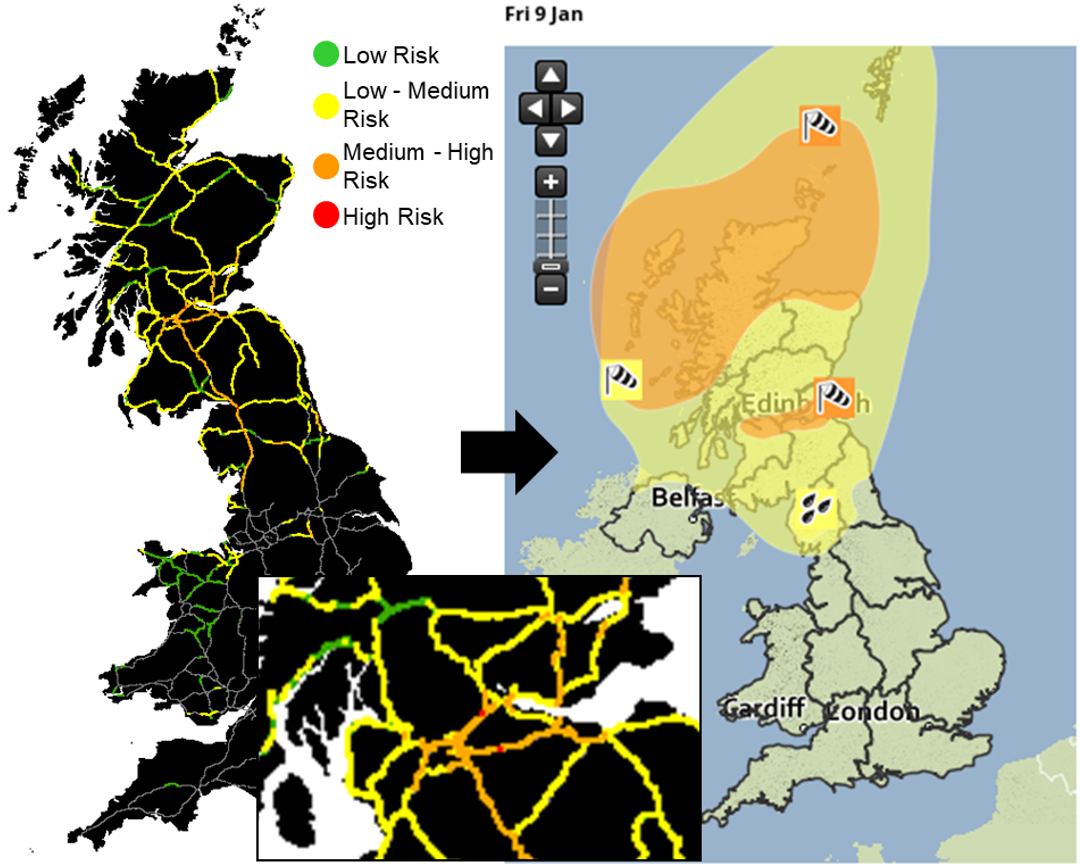The Vehicle OverTurning Model
August 2019 – New research published last month presents the methods used to develop the Vehicle OverTurning Model, a prototype Hazard Impact Model that supports impact-based forecasting and warning.
Decision-making by users of weather forecasts and warnings is better supported if users can understand the expected impact of the weather on their assets or activities – what the weather will do rather than just what the weather will be. Impact-based forecasts and warnings are increasingly used to support such decision-making.
This new research describes the development of the Vehicle OverTurning (VOT) Model and its use to support the production of National Severe Weather Warning Service (NSWWS) wind warnings by highlighting areas of the road network that are at risk of disruption due to vehicle overturning incidents.
Forecasting the potential impacts of severe weather events is challenging and can often be subjective. Hazard Impact Models, like the VOT model, are one way to reduce subjectivity as they aim to describe how a specific hazard (e.g. strong winds) interacts with assets (e.g. road networks) and users (e.g. road vehicles and drivers) to infer whether impacts are likely to occur.
The VOT model combines probabilistic wind hazard forecast information with vulnerability and exposure data to produce a forecast of the risk of vehicle overturning across the major trunk road network of Great Britain. This information can be used to support the issuance of NSWWS wind warnings and provide additional spatial and temporal detail about potential impacts.

VOT model output from 8th January 2015, 21:00 UTC run, valid for 9th January 2015 02:00 UTC and the updated and modified NSWWS Warnings based on the VOT model forecasts.
The VOT model uses minimum accident wind gust speeds defined as the wind gusts required to overturn unloaded and loaded HGVs (heavy good vehicles), unloaded LGVs (light goods vehicles) and cars. The hazard forecast probability for each vehicle type and forecast lead time is estimated by the proportion of ensemble members that exceed each wind gust threshold over a segment of the road network in the Met Office high resolution ensemble forecast system, MOGREPS-UK.
A vulnerability index is used to describe the characteristics of the road network which make it susceptible to wind-induced vehicle overturning. Four indicators are used to derive the vulnerability index. These are: (1) the mean altitude of each <=2km road segment, (2) the number of lanes per <=2km road segment, (3) infrastructure attributes (e.g. bridge, tunnel or slip road) and (4) road orientation relative to the forecast wind direction. Individual indicators are combined to produce a vulnerability index between 0 (low vulnerability) and 1 (high vulnerability).
Department for Transport Annual Average Daily Flow data are used to describe the variability in the exposed vehicle population as the hazard severity increases, and the number of vehicles that are exposed to the hazard at each road segment and forecast lead time.
By combining hazard, vulnerability and exposure in this way an objective, consistent assessment of the potential risk to road users during high wind events can be provided to operational meteorologists, to inform where and when weather warnings related to road transport should be issued.
Future research
It is important that the VOT model methodology be evaluated against observed occurrences of vehicle overturning incidents and tested to ensure the design, with its assumptions and caveats, is robust.
It is also important that the output of the VOT model be tested with users, including Operational Meteorologists at the Met Office and embedded forecasters and advisors at National Highways. This is critical to ensure that the forecasts are useful and usable and are effective at supporting decision making. Feedback from trials with these users will help inform how the VOT model can be improved and determine the value of Hazard Impact Models to different user groups.
Related research
Notes to reader
The paper, Developing a hazard impact model to support impact-based forecasts and warnings: The Vehicle OverTurning Model (doi: 10.1002/met.1819), was published in Meteorological Applications on 3rd July 2019.





